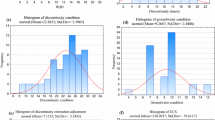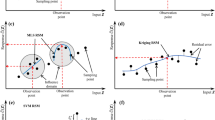Abstract
Circular failure is generally observed in the slope of soil, highly jointed rock mass, mine dump and weak rock. Accurate estimation of the safety factor (SF) of slopes and their performance is not an easy task. In this research, based on rock engineering systems (RES), a new approach for the estimation of the SF is presented. The introduced model involves six effective parameters on SF [unit weight (γ), pore pressure ratio (r u), height (H), angle of internal friction (φ), cohesion (C) and slope angle (\(\beta\))], while retaining simplicity as well. In the case of SF prediction, all the datasets were divided randomly to training and testing datasets for proposing the RES model. For comparison purposes, nonlinear multiple regression models were also employed for estimating SF. The performances of the proposed predictive models were examined according to two performance indices, i.e., coefficient of determination (R 2) and mean square error. The obtained results of this study indicated that the RES is a reliable method to predict SF with a higher degree of accuracy in comparison with nonlinear multiple regression models.
Similar content being viewed by others
References
Bahri Najafi A, Saeedi GR, Ebrahimi Farsangi MA (2014) Risk analysis and prediction of out-of-seam dilution in longwall mining. Int J Rock Mech Min Sci 70:115–122
Benardos A, Kaliampakos D (2004) A methodology for assessing geotechnical hazards for TBM tunnelling—illustrated by the Athens Metro, Greece. Int J Rock Mech Min Sci 41:987–999
Bhandari T, Hamad F, Moormann C, Sharma KG, Westrich B (2016) Numerical modelling of seismic slope failure using MPM. Comput Geotech 75:126–134. doi:10.1016/j.compgeo.2016.01.017
Bray JW, Hoek E (1981) Rock slope engineering. Taylor & Francis, London
Cheng Y, Lansivaara T, Wei W (2007a) Two-dimensional slope stability analysis by limit equilibrium and strength reduction methods. Comput Geotech 34:137–150
Cheng Y, Li L, S-c Chi, Wei W (2007b) Particle swarm optimization algorithm for the location of the critical non-circular failure surface in two-dimensional slope stability analysis. Comput Geotech 34:92–103
Duncan JM (1996) Soil slope stability analysis. In: Landslides, investigation and mitigation, vol 247. Transportation Research Board Special Report, US National Research Council, pp 337–371
Duncan JM (1996b) State of the art: limit equilibrium and finite-element analysis of slopes. J Geotech Eng 122:577–596
Ercanoglu M, Gokceoglu C (2002) Assessment of landslide susceptibility for a landslide-prone area (north of Yenice, NW Turkey) by fuzzy approach. Environ Geol 41:720–730
Faramarzi F, Farsangi ME, Mansouri H (2013a) An RES-based model for risk assessment and prediction of backbreak in bench blasting. Rock Mech Rock Eng 46:877–887
Faramarzi F, Mansouri H, Ebrahimi Farsangi M (2013b) A rock engineering systems based model to predict rock fragmentation by blasting. Int J Rock Mech Min Sci 60:82–94
Fattahi H, Moradi A (2017a) Risk assessment and estimation of TBM penetration rate using RES-based model. Geotech Geol Eng 35:365–376
Fattahi H, Moradi A (2017b) A new approach for estimation of the rock mass deformation modulus: a rock engineering systems-based model. Bull Eng Geol Environ. doi:10.1007/s10064-016-1000-5
Griffiths D, Fenton GA (2004) Probabilistic slope stability analysis by finite elements. J Geotech Geoenviron 130:507–518
Griffiths D, Lane P (1999) Slope stability analysis by finite elements. Geotechnique 49:387–403
Gu T, Wang J, Fu X, Liu Y (2015) GIS and limit equilibrium in the assessment of regional slope stability and mapping of landslide susceptibility. Bull Eng Geol Environ 74:1105–1115. doi:10.1007/s10064-014-0689-2
Hudson JA (1992) Rock engineering systems: theory and practice. Horwood, Chichester
Jiang Q, Qi Z, Wei W, Zhou C (2015) Stability assessment of a high rock slope by strength reduction finite element method. Bull Eng Geol Environ 74:1153–1162. doi:10.1007/s10064-014-0698-1
Kahatadeniya KS, Nanakorn P, Neaupane KM (2009) Determination of the critical failure surface for slope stability analysis using ant colony optimization. Eng Geol 108:133–141
Kaunda RB, Chase RB, Kehew AE, Kaugars K, Selegean JP (2010) Neural network modeling applications in active slope stability problems. Environ Earth Sci 60:1545–1558
Kaya A (2016) Geotechnical assessment of a slope stability problem in the Citlakkale residential area (Giresun, NE Turkey). Bull Eng Geol Environ. doi:10.1007/s10064-016-0896-0
Li XZ, Xu Q (2016) Application of the SSPC method in the stability assessment of highway rock slopes in the Yunnan province of China. Bull Eng Geol Environ 75:551–562. doi:10.1007/s10064-015-0792-z
Li D-Q, Qi X-H, Cao Z-J, Tang X-S, Phoon K-K, Zhou C-B (2016) Evaluating slope stability uncertainty using coupled Markov chain. Comput Geotech 73:72–82. doi:10.1016/j.compgeo.2015.11.021
Lim K, Li AJ, Lyamin AV (2015) Three-dimensional slope stability assessment of two-layered undrained clay. Comput Geotech 70:1–17. doi:10.1016/j.compgeo.2015.07.011
Lin P, Su M, Lin M, Lee T (1990) Investigation on the failure of a building constructed on a hillslope. In: Proceedings of the 2nd international symposium on field measurements in geomechanics, Kobe, 6–9 April 1987 V1. A.A. Balkema, Rotterdam, pp P547–P555. Int J Rock Mech Min Sci Geomech Abstr 2:A114
Luo N, Bathurst RJ, Javankhoshdel S (2016) Probabilistic stability analysis of simple reinforced slopes by finite element method. Comput Geotech 77:45–55
Madzic E (1988) Stability of unstable final slope in deep open iron mine landslides, vol 1. Balkema, Rotterdam, pp 455–458
Manouchehrian A, Gholamnejad J, Sharifzadeh M (2014) Development of a model for analysis of slope stability for circular mode failure using genetic algorithm. Environ Earth Sci 71:1267–1277
Martel SJ, Muller JR (2000) A two-dimensional boundary element method for calculating elastic gravitational stresses in slopes. Pure Appl Geophys 157:989–1007
McCombie P, Wilkinson P (2002) The use of the simple genetic algorithm in finding the critical factor of safety in slope stability analysis. Comput Geotech 29:699–714
Nash D (1981) A comparative review of limit equilibrium methods of stability analysis, Slope Stability. In: Anderson MG, Richards KS (eds) Wiley, New York, pp 11–75
Nash D (1987) Comparative review of limit equilibrium methods of stability analysis slope stability: geotechnical engineering and geomorphology. Wiley, New York, pp 11–75
Pradhan B (2010) Application of an advanced fuzzy logic model for landslide susceptibility analysis Inte. J Comput Intell Syst 3:370–381
Qi C, Wu J, Liu J, Kanungo DP (2016) Assessment of complex rock slope stability at Xiari, southwestern China. Bull Eng Geol Environ 75:537–550. doi:10.1007/s10064-015-0763-4
Saboya F Jr, da Glória Alves M, Dias Pinto W (2006) Assessment of failure susceptibility of soil slopes using fuzzy logic. Eng Geol 86:211–224
Saffari A, Ataei M, Ghanbari K (2013) Applying rock engineering systems (RES) approach to evaluate and classify the coal spontaneous combustion potential in Eastern Alborz coal mines. Int J Min Geol Eng 47:115–127
Sah N, Sheorey P, Upadhyaya L (1994) Maximum likelihood estimation of slope stability. Int J Rock Mech Min Sci 31:47–53
Salmi EF, Hosseinzadeh S (2015) Slope stability assessment using both empirical and numerical methods: a case study. Bull Eng Geol Environ 74:13–25. doi:10.1007/s10064-013-0565-5
Sun S, Sun H, Wang Y, Wei J, Liu J, Kanungo DP (2014) Effect of the combination characteristics of rock structural plane on the stability of a rock-mass slope. Bull Eng Geol Environ 73:987–995. doi:10.1007/s10064-014-0593-9
Tschuchnigg F, Schweiger HF, Sloan SW (2015) Slope stability analysis by means of finite element limit analysis and finite element strength reduction techniques. Part II: back analyses of a case history. Comput Geotech 70:178–189. doi:10.1016/j.compgeo.2015.07.019
Tun YW, Pedroso DM, Scheuermann A, Williams DJ (2016) Probabilistic reliability analysis of multiple slopes with genetic algorithms. Comput Geotech 77:68–76. doi:10.1016/j.compgeo.2016.04.006
Wang B, Vardon PJ, Hicks MA (2016) Investigation of retrogressive and progressive slope failure mechanisms using the material point method. Comput Geotech 78:88–98. doi:10.1016/j.compgeo.2016.04.016
Xu J (2011) Debris slope stability analysis using three-dimensional finite element method based on maximum shear stress theory. Environ Earth Sci 64:2215–2222
Yu H, Salgado R, Sloan S, Kim J (1998) Limit analysis versus limit equilibrium for slope stability. J Geotech Geoenviron 124:1–11
Zhang J-F, Ding H (2005) Generalized 3D limit-equilibrium method for slope stability analysis and its application. Chin J Rock Mech Eng 3:1–12
Zhu D, Lee C, Jiang H (2003) Generalised framework of limit equilibrium methods for slope stability analysis. Geotechnique 53:377–395
Zolfaghari AR, Heath AC, McCombie PF (2005) Simple genetic algorithm search for critical non-circular failure surface in slope stability analysis. Comput Geotech 32:139–152
Author information
Authors and Affiliations
Corresponding author
Rights and permissions
About this article
Cite this article
Fattahi, H. Risk assessment and prediction of safety factor for circular failure slope using rock engineering systems. Environ Earth Sci 76, 224 (2017). https://doi.org/10.1007/s12665-017-6549-1
Received:
Accepted:
Published:
DOI: https://doi.org/10.1007/s12665-017-6549-1









